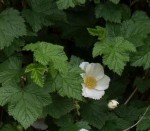 Brambles may not be at the top of your list of favorite garden shrubs but many are ornamental and deserve a place in the garden. The most common Rubus species are blackberries and raspberries, known for their fierce prickles but there are many other species that may be grown for their flowers, foliage, and/or bark. Rubus belongs to the rose family (Rosaceae), a large diverse family that also includes cherry, hawthorn, and lady’s mantle.
Brambles may not be at the top of your list of favorite garden shrubs but many are ornamental and deserve a place in the garden. The most common Rubus species are blackberries and raspberries, known for their fierce prickles but there are many other species that may be grown for their flowers, foliage, and/or bark. Rubus belongs to the rose family (Rosaceae), a large diverse family that also includes cherry, hawthorn, and lady’s mantle.
Here are five Rubus species that are grown for their flowers:
R. spectabilis ‘Olympia Double’
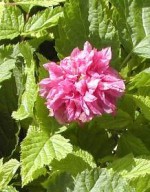 Also known as salmonberry this deciduous shrub is native to moist forests and stream margins of the west coast of North America from west central Alaska to California, east to Idaho. The stems are covered with fine prickles and carry pinnately compound leaves with three toothed leaflets 1-3 inches long. In early spring rich cerise double flowers appear that give way to translucent coral fruits, attractive to birds.
Also known as salmonberry this deciduous shrub is native to moist forests and stream margins of the west coast of North America from west central Alaska to California, east to Idaho. The stems are covered with fine prickles and carry pinnately compound leaves with three toothed leaflets 1-3 inches long. In early spring rich cerise double flowers appear that give way to translucent coral fruits, attractive to birds.
Size: 6-10’ H x 6-10’ W
Flower Color: Cerise
Light: Partial shade
Soil: Average, moist
Hardiness: Zones 5-9
R. parviflorus
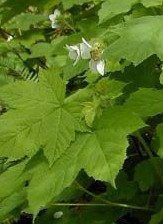 Another native species, known as thimbleberry, is found on the west coast of North America from Alaska to Mexico., east to the Rocky Mountains. Its thornless stems carry deeply lobed, velvety leaves up to ten inches long and produce 2-2 ½ inch wide flowers with white slightly crinkled petals in mid- to late spring. The edible fruit looks similar to a small raspberry but is softer so does not pack well and is not grown commercially. Plants often form clumps or dense thickets by rhizomes.
Another native species, known as thimbleberry, is found on the west coast of North America from Alaska to Mexico., east to the Rocky Mountains. Its thornless stems carry deeply lobed, velvety leaves up to ten inches long and produce 2-2 ½ inch wide flowers with white slightly crinkled petals in mid- to late spring. The edible fruit looks similar to a small raspberry but is softer so does not pack well and is not grown commercially. Plants often form clumps or dense thickets by rhizomes.
Size: 7-10’ H
Flower Color: White
Light: Full sun to partial shade
Soil: Average, moist to dry
Hardiness: Zones 3-9
Rubus ‘Brenden’
 A cross between R. trilobus and R. deliciosus , ‘Brenden’ produces white flowers three inches across in mid-spring on thornless, arching canes with pale brown, peeling bark. The mid-green leaves are have five shallow lobes and are up to three inches across. Unlike most other flowring shrubs, ‘Brenden’ can tolerate deep shade.
A cross between R. trilobus and R. deliciosus , ‘Brenden’ produces white flowers three inches across in mid-spring on thornless, arching canes with pale brown, peeling bark. The mid-green leaves are have five shallow lobes and are up to three inches across. Unlike most other flowring shrubs, ‘Brenden’ can tolerate deep shade.
Size: 9’ H x 9’ W
Flower Color: White
Light: Sun to shade
Soil: Average, moist, well-drained
Hardiness: Zones 5-9
R. ichangensis
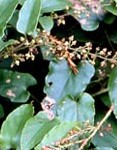 This deciduous shrub is a native of east Asia, and central and east China, where it grows in forests, ravines, and open fields. Prickly, branched, arching stems bear glossy triangular leaves up to six inches long and small white flowers in clusters up to twenty inches long in midsummer.
This deciduous shrub is a native of east Asia, and central and east China, where it grows in forests, ravines, and open fields. Prickly, branched, arching stems bear glossy triangular leaves up to six inches long and small white flowers in clusters up to twenty inches long in midsummer.
Size: 4-6’ H x 4’ W
Flower Color: White
Light: Full sun to part shade
Soil: Average, moist, well-drained
Hardiness: Zones 6-9
R. rosifolius’Coronarius’
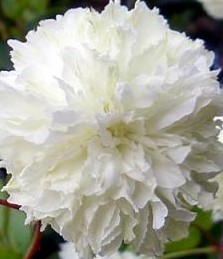 Also known as roseleaf bramble, this climbing evergreen shrub is native to eastern Himalayas, East Asia and eastern Australia where it grows in forest margins, clearnings, and gullies.. The hairy prickly stems bear pinnately compound leaves with five to seven glossy ovate prickly leaflets up to three inches long. The ivory colored flowers are produced in abundance during mid spring and are large, very double, and two inches across.
Also known as roseleaf bramble, this climbing evergreen shrub is native to eastern Himalayas, East Asia and eastern Australia where it grows in forest margins, clearnings, and gullies.. The hairy prickly stems bear pinnately compound leaves with five to seven glossy ovate prickly leaflets up to three inches long. The ivory colored flowers are produced in abundance during mid spring and are large, very double, and two inches across.
Size: 4’ H x 6’ H
Flower Color: Ivory
Light:
Soil: Average, medium moist, well-drained
Hardiness: Zones 8-9